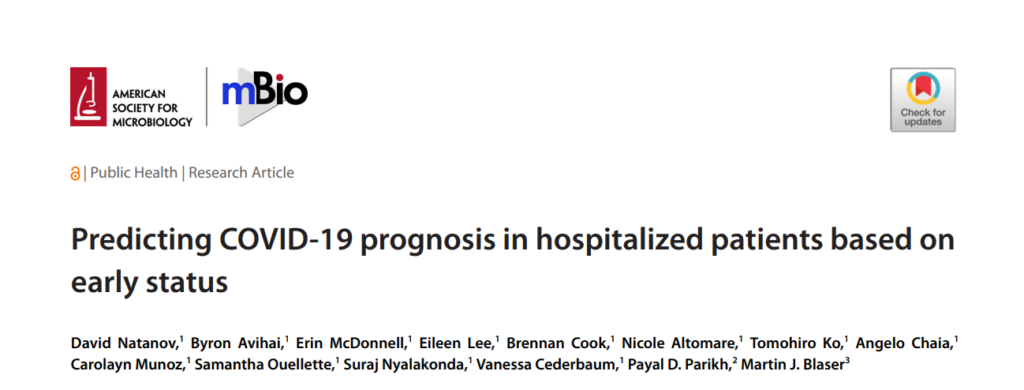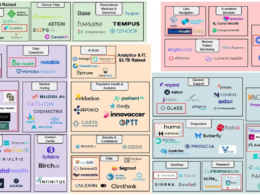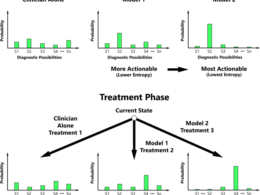the health strategist
institute for strategic health transformation
& digital technology
Joaquim Cardoso MSc.
Chief Research and Strategy Officer (CRSO),
Chief Editor and Senior Advisor
October 13, 2023

What is the message?
Rutgers researchers have developed a machine-learning tool that uses patient age and results from five routine tests to predict the progression of COVID-19.
This model aims to help hospitals identify life-threatening cases of COVID-19 and can significantly improve outcomes for patients hospitalized with the virus.
The tool, named PLABAC, has been validated by successfully predicting outcomes for patients with COVID-19 variants beyond the original virus, making it a potentially valuable tool for healthcare providers.
The ease of use and compatibility with data already collected by hospitals make it a practical addition to healthcare systems.
DEEP DIVE

Six Numbers Predict Life-Threatening COVID-19
Rutgers
Andrew Smith
September 25, 2023
Rutgers researchers developed a way to help hospitals identify life-threatening COVID-19 cases using machine-learning software.
The newly developed tool uses patient age and results from five routine tests to predict coronavirus disease progression. Its creators said they believe this new model could significantly improve outcomes for patients hospitalized with the virus, which remains the nation’s third leading cause of death.
“Accurate prognoses are extremely valuable,” said Payal Parikh, an internist, Robert Wood Johnson Medical School (RWJMS) associate professor and coauthor of the new paper in the journal mBio. “They let patients understand what’s coming while they’re still healthy enough to make informed treatment choices. They also let hospitals allocate resources efficiently by anticipating patient needs. Also, with better prognostication, we can start treatment early in the disease process, which leads to better patient care outcomes.”
The Rutgers team began its quest to build a COVID-19 prognostication model with machine-learning software and medical records from 969 people who were hospitalized with the virus early in the pandemic.
“We took a bunch of data points from each patient – lab results, demographics, vital signs, comorbidities, and dozens more,” said David Natanov, a fourth-year RWJMS student who is the study’s lead author. “We pumped that through a series of different machine-learning models tuned to slightly different parameters and generated an initial 77-variable model. That model performed well, but no one has time to enter 77 separate data points into anything.”
Natanov said researchers used various analytical tools to identify the 10 most predictive variables associated with the disease. It then used artificial intelligence to look at them in various combinations until finding two effective models comprised of six data points (age and results from five common lab tests) every hospital is collecting.
The researchers dubbed the most accurate of their models PLABAC, an acronym of the first letter of each component variable: platelet count, lactate, age, blood urea nitrogen, aspartate aminotransferase and C-reactive protein.
To make sure PLABAC predicted mortality for all patients hospitalized with COVID-19 rather than just the 969 people in the initial sample, the researchers used it – successfully – to project outcomes for another 7,901 patients hospitalized in the pre-vaccination period and a third group of 1,547 from the post-vaccination period.
The strong results in patients hospitalized after vaccines show PLABAC can predict the prognosis of patients with COVID-19 variants beyond the original virus that infected the first patient group.
The Rutgers team isn’t the first to use old patient records to create a COVID-19 progression model, but its members believe they are the first to validate their model by successfully testing its ability to predict outcomes for a second (and third) group of patients.
They also believe their model has another key benefit over others they have seen: ease of use. Most hospitals already collect all six data points on COVID-19 patients. The only extra work is typing those six variables into the formula – and the study team hopes to make it easier still.
“I plan to reach out to MDCalc, an app that every clinician has on their phone to look stuff up and use helpful formulas,” Natanov said. “I’d love to get the formula for this added so users could get a prognosis simply by typing in the six numbers.”
Natanov said he would like to work with Epic, the largest maker of electronic health record software, to add this model to its growing list of predictive tools.
“No one would have to enter anything. The system would just automatically pull the numbers from the lab results and make the calculation,” he said.
Originally published at https://www.rutgers.edu
REFERENCE PUBLICATION

8 September 2023
Predicting COVID-19 prognosis in hospitalized patients based on early status
Authors: David Natanov https://orcid.org/0000-0002-0249-8872, Byron Avihai, Erin McDonnell, Eileen Lee, Brennan Cook, Nicole Altomare, Tomohiro Ko, SHOW ALL (14 AUTHORS), Martin J. Blaser
David Natanov,1 Byron Avihai,1
Erin McDonnell,1
Eileen Lee,1 Brennan Cook,1 Nicole Altomare,1
Tomohiro Ko,1 Angelo Chaia,1
Carolayn Munoz,1
Samantha Ouellette,1
Suraj Nyalakonda,1 Vanessa Cederbaum,1 Payal D. Parikh,2 Martin J. Blaser3












